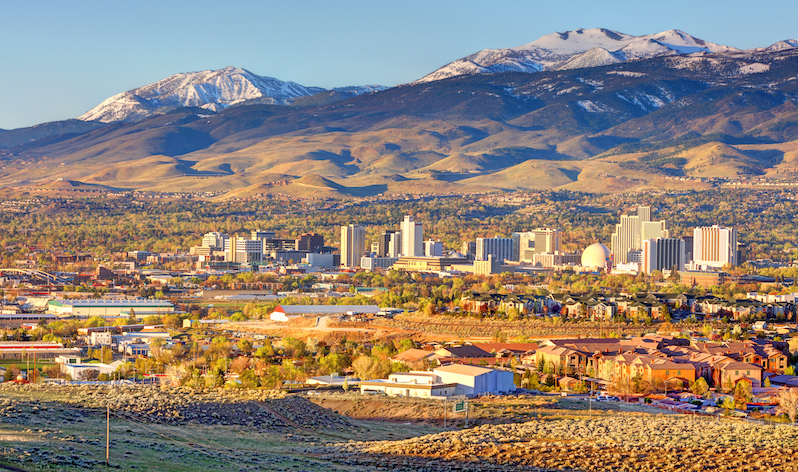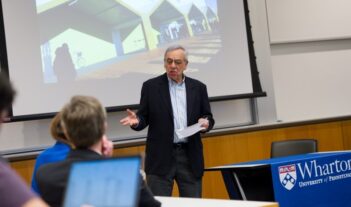
Nevada offers a case study of how states can succeed in attracting new employers.
Nevada carries a reputation as a one-horse state, relying mainly on the leisure and hospitality sector. For example, in 2019, accommodation and food services made up 26 percent of Nevada’s workforce. For many years, policymakers and analysts have argued that Nevada needed to diversify its economy like its neighbors Arizona and Utah. This notion has proven salient multiple times, such as during the 2008 Great Recession and the COVID-19 pandemic, when Nevada, and especially the Las Vegas metro area, became ground zero for a national economic slump.
Former Governor Brian Sandoval, along with the Nevada legislature, placed economic development decisions within the Governor’s Office on Economic Development (GOED) in 2011, bringing that authority into the governor’s office for the first time. The key goal of the move was to prioritize and expedite diversification of Nevada’s economy, especially around the state’s major metro areas of Reno and Las Vegas.
Progress since then has been a tale of two cities.
In the north, Reno attracted the Tesla battery gigafactory into the Tahoe-Reno Industrial Center (TRIC) in 2014, which attracted other firms in the gigafactory’s supply chain and related fields. The development of TRIC led to a significant reduction in Reno’s reliance on the leisure and hospitality sector for economic activity as demonstrated by its performance during the pandemic and its aftermath. The unemployment rate in Reno sat at 2.6 percent as of May 2022 and has been quick to recover from its peak unemployment of 18.3 percent in April 2020. Today, the accommodation and food services industry makes up a smaller percentage of the workforce (13 percent) than it did 20 years ago despite Reno adding about 48,650 workers.
In the south, Las Vegas saw hope of similar activity in 2015 from Faraday Future, an electric car company that had planned to build a large assembly plant in Apex industrial park. Unfortunately, not long after beginning work at the Apex site, Faraday Future withdrew in 2017 due to financial shortfalls despite similar tax incentives and abatements as the Tesla gigafactory. Since then, no significant electric vehicle company has moved to the state. The unemployment rate in Las Vegas in May was 5.3 percent, which took a much longer time to come down from a high of 31.2 percent in April 2020. Today, over one in four workers in southern Nevada work in accommodation and food services, which is down from one in three 20 years ago but still much higher than in Reno.
Generally, states can attract firms through tax abatements and other inducements. This competition can be modeled as a simple two-state game, where both states are better off by cooperating and not offering incentives. But the most common outcome, known as a Nash equilibrium, occurs when both states offer incentives out of fear of losing out should the other state “not cooperate” and offer incentives. Each state is trying to improve on the profits they might have gained through the cooperative outcome. But this noncooperation leads to the worst outcome because conflict is costly.
Who benefits from the use of economic development incentives? Economist Timothy J. Bartik developed a simulation model to examine the effects of economic development incentives, such as tax abatements and other inducements, on the incomes of local residents. His study concludes that the incentives produce positive net benefits only under certain conditions, such as in sectors with high job creation. Negative net benefits can occur if, for example, incentives reduce spending for K-12 education.
Policymakers considering tax incentives should note political philosopher John Rawls’ “difference principle,” which affirms that the extent of inequality should only be to the advantage of the worst-off member of society, in this case, the most vulnerable to the reduction in tax collection.
Returning to Nevada, GOED offers a menu of possible tax abatements for taxes including sales and use tax, modified business tax, personal property tax, and real property tax for recycling abatements. The Nevada legislature implemented performance contracts on its tax abatement deals, which means that the benefitting company only receives the agreed-upon benefits once the company meets certain program benchmarks. For example, when Tesla and Panasonic located their gigafactory in northern Nevada, their performance requirements included $3.5 billion in capital expenditure over 10 years. Moreover, to obtain the maximum value of certain tax credits, the state’s incentive package required Tesla to pay a wage of $22 per hour. The total amount of tax breaks granted to Tesla and Panasonic is estimated at $1.25 billion if they use all of them. Today, Panasonic and Tesla combined employ around 7,000 workers at the gigafactory.
Southern Nevada has not been completely left in the dust when it comes to economic diversification. Haas Automation, one of the world’s largest machine toolers, announced in 2019 a $327 million, 2.5 million square foot manufacturing facility in southern Nevada that will create 1,400 new jobs within the first five years. In addition to tax incentives and abatements, what stood out about the project was the local authorities’ commitment to a dedicated workforce. Together, GOED, Haas Automation, the city, and the local community college built a workforce training center to jumpstart training programs for Haas, specifically around computer-controlled machine operations and ensuring the workers mostly come from Nevada.
This model could be a spring of hope for future economic development agreements.





